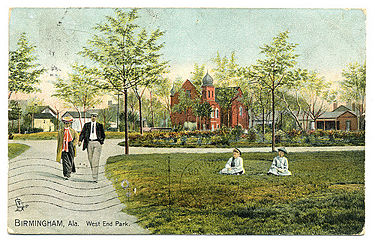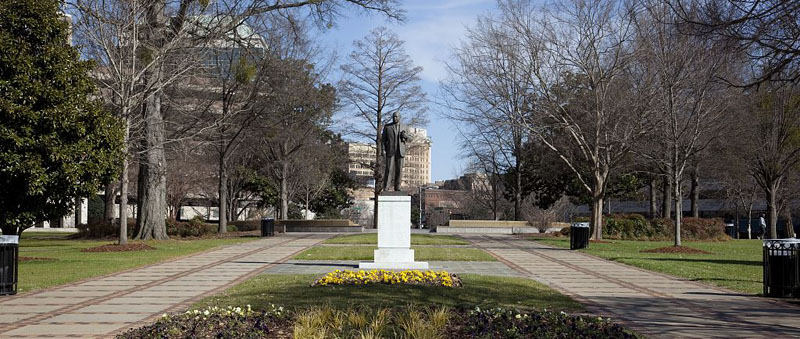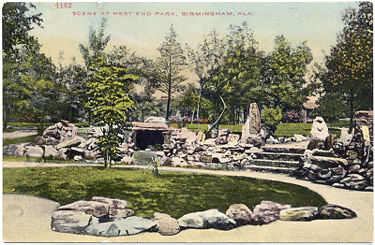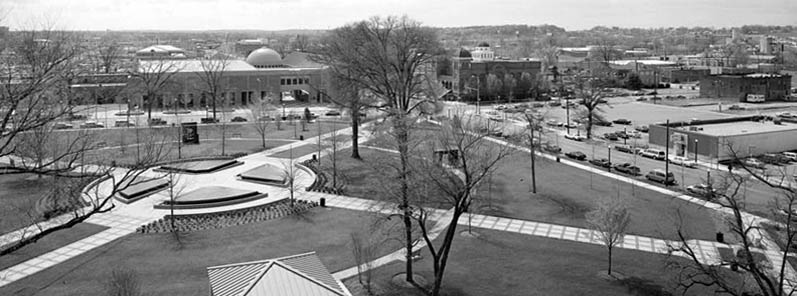Kelly Ingram Park: Difference between revisions
m (→External links: Locate template.) |
|||
| Line 19: | Line 19: | ||
In [[1990]], during the early stages of planning for the [[Birmingham Civil Rights Institute]], Mayor [[Richard Arrington]] attended a Mayors' Institute on City Design session hosted by Tulane University in New Orleans, Louisiana, where he presented the project to professional planners. The group, led by Tulane Regional Urban Design Center director Grover Mouton, quickly identified the potential of using the open space of Kelly Ingram Park as a major component of a larger [[Civil Rights District]]. The concept evolved into redesigning the park as "A Place of Revolution and Reconciliation," and using art to enhance the interpretive program of the Institute. | In [[1990]], during the early stages of planning for the [[Birmingham Civil Rights Institute]], Mayor [[Richard Arrington]] attended a Mayors' Institute on City Design session hosted by Tulane University in New Orleans, Louisiana, where he presented the project to professional planners. The group, led by Tulane Regional Urban Design Center director Grover Mouton, quickly identified the potential of using the open space of Kelly Ingram Park as a major component of a larger [[Civil Rights District]]. The concept evolved into redesigning the park as "A Place of Revolution and Reconciliation," and using art to enhance the interpretive program of the Institute. | ||
Opened in [[1992]], the park is the setting for several pieces of sculpture related to the Civil Rights Movement. Besides a central fountain and a large commemorative statue of [[Martin Luther King, Jr]], there are three powerfully charged installations by artist [[James Drake]] which flank a circular "[[Freedom Walk]]" and bring the visitor inside the portrayals of terror and sorrow of the 1963 confrontations. Additional monuments honor [[Pauline Fletcher]], [[Carrie Tuggle]], [[Ruth Jackson]], [[Arthur Shores]], [[Julius Ellsberry]] | Opened in [[1992]], the park is the setting for several pieces of sculpture related to the Civil Rights Movement. Besides a central fountain and a large commemorative statue of [[Martin Luther King, Jr]], there are three powerfully charged installations by artist [[James Drake]] which flank a circular "[[Freedom Walk]]" and bring the visitor inside the portrayals of terror and sorrow of the 1963 confrontations. [[Ronald McDowell]]'s "[[The Foot Soldier]]" is also located on the circular path on the south side of the park. Additional monuments honor [[Pauline Fletcher]], [[Carrie Tuggle]], [[Ruth Jackson]], [[Arthur Shores]], and [[Julius Ellsberry]]. | ||
A limestone [[Kneeling ministers statue|sculpture by Raymond Kasky]] depicts three ministers, [[John Thomas Porter]], [[Nelson H. Smith]] and [[A. D. King]], kneeling in prayer. One corner of the park remembers other "unsung heroes"' of Birmingham's underrepresented. | A limestone [[Kneeling ministers statue|sculpture by Raymond Kasky]] depicts three ministers, [[John Thomas Porter]], [[Nelson H. Smith]] and [[A. D. King]], kneeling in prayer. One corner of the park remembers other "unsung heroes"' of Birmingham's underrepresented. | ||
Revision as of 19:28, 25 June 2014
Kelly Ingram Park is a four acre park located in between 16th and 17th Streets and 5th and 6th Avenue North in the Birmingham's Civil Rights District. The park, just outside the doors of the Sixteenth Street Baptist Church, served as a central staging ground for large-scale demonstrations during the Civil Rights movement of the 1960s.
History

First known as West Park, the block was set aside as a park by the Elyton Land Company shortly after its initial plat was created. In the early days the park featured a stone grotto. Later called West End Park, it was also one of the University of Alabama football team's home fields between 1901 and 1904. The 1902, 1904, and 1905 rivalry games against what would become Auburn University were played there. Alabama has a 3-5-1 overall record from its games at West End Park.
The park was renamed in 1932 for local firefighter Osmond Kelly Ingram, who was the first sailor in the United States Navy to be killed in World War I. A monument to Ingram, consisting of a massive boulder with attached bronze plaques, was erected in the northwest corner of the park.
Civil Rights Movement
Reverends Martin Luther King, Jr. and Fred Shuttlesworth directed the organized boycotts and protests of 1963 which centered on Kelly Ingram Park. It was here, during the first week of May 1963 that Birmingham police and firemen, under orders from Public Safety Commissioner Bull Connor, confronted demonstrators, many of them children, first with mass arrests and then with police dogs and firehoses. Images from those confrontations, broadcast nationwide, spurred a public outcry which turned the nation's attention to the struggle for racial equality and helped insure the passage of Civil Rights laws and bring an end to public segregation.
Current park
In 1990, during the early stages of planning for the Birmingham Civil Rights Institute, Mayor Richard Arrington attended a Mayors' Institute on City Design session hosted by Tulane University in New Orleans, Louisiana, where he presented the project to professional planners. The group, led by Tulane Regional Urban Design Center director Grover Mouton, quickly identified the potential of using the open space of Kelly Ingram Park as a major component of a larger Civil Rights District. The concept evolved into redesigning the park as "A Place of Revolution and Reconciliation," and using art to enhance the interpretive program of the Institute.
Opened in 1992, the park is the setting for several pieces of sculpture related to the Civil Rights Movement. Besides a central fountain and a large commemorative statue of Martin Luther King, Jr, there are three powerfully charged installations by artist James Drake which flank a circular "Freedom Walk" and bring the visitor inside the portrayals of terror and sorrow of the 1963 confrontations. Ronald McDowell's "The Foot Soldier" is also located on the circular path on the south side of the park. Additional monuments honor Pauline Fletcher, Carrie Tuggle, Ruth Jackson, Arthur Shores, and Julius Ellsberry.
A limestone sculpture by Raymond Kasky depicts three ministers, John Thomas Porter, Nelson H. Smith and A. D. King, kneeling in prayer. One corner of the park remembers other "unsung heroes"' of Birmingham's underrepresented.
Currently the park hosts several local family festivals and cultural and entertainment events throughout the year. The Civil Rights Institute provides audio-tour guides for the park which feature remembrances by many of the figures directly involved in the confrontations. Urban Impact, Inc. also provides guided tours by appointment.
In June 2008 two homeless men, Juan Perkins and Reginald Sanders, were arrested for "impersonating public servants" by trying to charge visitors for tours of the park. In November 2009 demonstrators with the "Tea Party Express II" caused controversy by selecting the park as the scene of their protests against the legitimacy of the Obama administration and against congressional plans to expand public healthcare coverage.
In 2010 BCRI board member Joel Rotenstreich led a drive to plant an Anne Frank tree in Kelly Ingram Park. Another group raised funds for a Four Spirits memorial to the girls killed in the 1963 church bombing. That work, by Elizabeth MacQueen, was dedicated on September 15, 2013, the 50th anniversary of the tragedy.
References
- "Kelly Ingram Park." Wikipedia, The Free Encyclopedia. 29 Mar 2006, 22:31 UTC. 29 Mar 2006, 22:34 [1].
- Gray, Jeremy (June 19, 2008) "Homeless men attempt to charge for Kelly Ingram Park tours." The Birmingham News
- Gordon, Robert K. (November 9, 2009) "Tea Party Express makes stop in Birmingham's Kelly Ingram Park." The Birmingham News
- Gilchrist, William (June 18, 2014) remarks at "ULI’s 2002 Study on Downtown Birmingham – Then and Now". Urban Land Institute, Atlanta chapter. Terrific New Theater, Birmingham. panel discussion.



